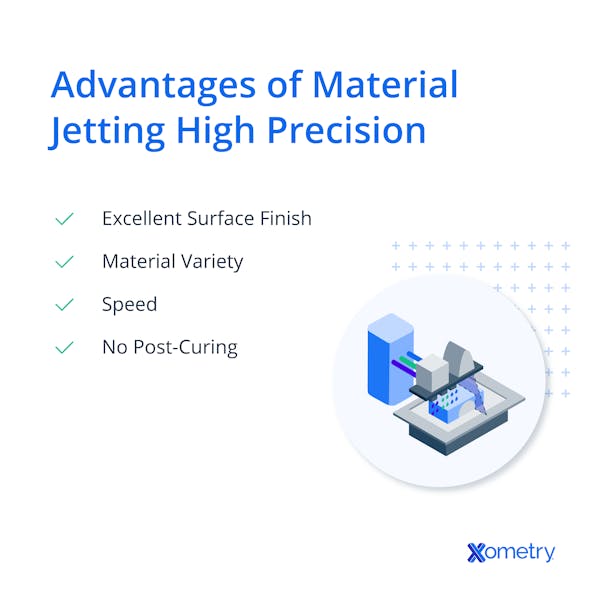As far as types of manufacturing go, 3D printing is one of the most impressive because of how quickly it can be developed and how many different types exist—including material jetting. This layer-by-layer method is versatile and can handle a wide range of materials to build exactly the product you need. If you’re intrigued by the process, get to know how it works below and the types of materials you can run through a material jetting printer.
What Is Material Jetting?
Like many other types of 3D printers, material jetting entails building an object through layers. However, it stands out from other types based on how those layers are built — it drips liquefied material onto the printing bed in the shape you’ve designed. The material used is photosensitive, and it’s cured through UV light.
To make sure this process runs smoothly, you’ll want to be aware of the different parts of a material jetting printer and what functions they provide. There are four major components, including the printheads, which are responsible for getting the material onto the build platform — another vital part. Then there is the material container, which holds onto the liquid resin before the printheads dispense it. Lastly, there’s a UV light, which is responsible for curing the finished build.
We’ve given a general idea of how material jetting works below.
How Does the Process of Material Jetting in a 3D Printer Work?
Here are the steps a printer takes to create a material jetted product:
- The first thing that’ll happen is the machine will heat up the resin or liquid material you’re using so it’s viscous enough to print.
- Then, the printhead will move based on directions from the design file and release small droplets of the resin onto the build platform.
- Once the first layer is done, the UV light will cure it and then the printhead will start on the second layer until the model is complete.
What Are the Different Components of Material Jetting in a 3D Printer?
The main components include:
- Printheads: Dispense the material onto the build platform.
- UV-Light Sources: Cure and solidify the deposited material.
- Build Platform: Where the part is constructed layer by layer.
- Material Container: Holds the liquid resin before it is jetted.
What Are the Different Materials That Can Be Material Jetted in a 3D Printer?
There are lots of different materials you can use with a material jetting printer, which might make it tougher to settle on one, but you’ll usually find it’s between polymers, plastics, and waxes. When you’re considering various resins, think about the mechanical properties your parts will need, the cost, how easy the material will be to process and finish, and how compatible this material is with your printer. Here are several of the materials you’ll find that work with a material jet printer:
1. Ceramics
Ceramics in material jetting are advanced due to their high temperature and wear resistance. The process involves jetting ceramic particles suspended in a photopolymer, which is then cured layer by layer with UV light. Post-processing includes the removal of the polymer matrix and sintering to enhance strength. This process is suitable for intricate geometries that are unattainable in standard ceramic manufacturing, which is why the aerospace, medical, and electronics industries find it ideal. The final products have outstanding chemical and thermal stability, which is often required under challenging conditions.
2. Metals
Material jetting for metals involves jetting fine droplets of a metal-infused binder onto a build platform. After deposition, these droplets are solidified through thermal or UV curing. The parts then undergo a debinding process to remove the binder, followed by sintering to fuse the metal particles. This technique allows for the creation of metal parts with intricate details and complex geometries that would be challenging to produce with traditional manufacturing methods. It's particularly useful for producing small, detailed components with a smooth surface finish in industries like jewelry and dental supplies, and in manufacturing prototypes.
3. Plastics
The plastics used in material jetting are photopolymers, which harden when exposed to ultraviolet light. The method is to create each layer of the desired object by putting tiny droplets of photopolymer onto a build platform. This process is renowned for its extreme precision and capacity to create objects with intricate details and flawless surfaces. Prototyping, consumer items, and dental and medical models are among its many applications. A wide range of mechanical qualities, from hard to flexible, are also possible with the diversity of photopolymers that are currently accessible, meeting the needs of a wide range of applications.
4. Composites
Composite materials in material jetting are created by combining two or more distinct materials to harness their combined properties. Typically, this involves embedding fibers or particles into a photopolymer matrix, which is then jetted and cured layer by layer. The result is a part that benefits from the strength and stiffness of the fibers while maintaining the versatility and design freedom of the matrix material. This technology is particularly beneficial for applications requiring parts with enhanced mechanical properties, such as in the automotive and aerospace sectors.
5. Waxes
The main purpose of waxes in material jetting is to create intricate patterns for mold-making and investment casting. The method is spraying melted and solidified materials that resemble wax to create the part's layers. The clean burnout characteristics of these materials are what make them ideal for molding without residue. In the jewelry and dental sectors, in which accuracy and attention to detail are critical, this application is essential. Traditional wax carving processes take a lot longer and cost a lot more money, but the material jetting can create complicated wax patterns quickly.
6. Resins
Resins, particularly photopolymers, are a cornerstone of material jetting. These liquid materials are jetted onto a build platform and cured using UV light, forming solid objects with high accuracy and smooth surface finishes. Resins offer a range of properties, including transparency, flexibility, and high-temperature resistance, making them suitable for a wide array of applications from prototyping to end-use parts in industries like: automotive, consumer products, and healthcare.
7. Silicones
Silicone materials are becoming more and more common in material jetting because of their heat resistance, flexibility, and biocompatibility. To create a solid elastomeric component, jetting silicone entails depositing droplets of a silicone prepolymer and curing them. The medical industry benefits greatly from this technology for creating custom prostheses and organ models due to silicone's similarity to human tissue in terms of feel and mechanical properties.
8. Bioinks
Bioinks are specialized materials designed for 3D printing tissues and organs. They consist of a biocompatible matrix, often a hydrogel, that supports cell growth and differentiation. In material jetting, bioinks are jetted and solidified to create scaffolds that mimic the extracellular matrix, providing a conducive environment for cells to form functional tissues. This technology holds promise for regenerative medicine, drug testing, and understanding disease mechanisms. The challenge lies in optimizing the material properties to ensure cell viability and function post-printing.
9. Photopolymers
Material jetting uses photopolymers because of their fast solidification under UV light. To create exact and intricate pieces, these liquid resins are injected into tiny droplets and then cured layer by layer. Photopolymers are adaptable and can be used for a wide range of applications, from end-use part manufacturing to prototyping, thanks to their ability to be manufactured with different qualities including: rigidity, transparency, and color. They are perfect for intricate components, consumer items, and dentistry applications due to their high resolution and flawless surface finish.
10. Support Materials
Support materials in material jetting are essential for creating overhangs and complex geometries. They are often jetted simultaneously with the build material and act as scaffolding during the printing process. These materials are designed to be easily removed post-printing, either by dissolution in a specific solvent or by manual removal. The ability to use support materials expands the design possibilities in material jetting, allowing for the creation of parts with intricate internal structures and moving components.
Each of these materials brings unique properties and advantages to the table, enabling the creation of parts that meet specific requirements for a wide range of applications. Material jetting continues to evolve, pushing the boundaries of what can be achieved in additive manufacturing.
How To Choose Material for Material Jetting 3D Printers?
When selecting a material for material jetting 3D printers, consider the following factors:
- Final Part Requirements: Determine the mechanical, thermal, and aesthetic properties needed.
- Material Properties: Assess the compatibility of material properties with your part's requirements.
- Cost: Factor in the material cost and its impact on the overall project budget.
- Availability: Ensure the chosen material is readily available and compatible with your printer.
- Post-Processing: Consider the ease of post-processing and the desired finish of the final part.
Is Material Jetting Necessary in 3D Printing?
No, material jetting is not necessary for all 3D printing applications. It is one of several technologies available, chosen for specific use cases whenever its advantages align with project requirements.
What Is the Advantage of Material Jetting 3D Printers?
Working with a material jetting printer has quite a few benefits, including the following:
- Precise: This method can print parts with intricate designs that other printers might not be able to render accurately.
- Top-Tier Aesthetics: This is a great type of 3D printing if you care about the surface finish of the product or if it’s an important part of its function or looks.
- Speed: You can expect products with a quicker turnaround thanks to this speedier printing type, especially in comparison to FDM.
- Easy curing: Since the UV light is built into the machine, you don’t have to cure the product after it has been printed.
- Adaptable: There are many applications this type of printing is good for, including making molds and accurate prototypes.

What Is the Disadvantage of Material Jetting 3D Printers?
There are also a handful of limitations to be mindful of before choosing this printing method:
- Material options: While there are plenty of plastics out there you can use with a material jetting printer, it’s limited when it comes to other types of materials.
- Cost: Material jetting 3D printing is usually more expensive than other types, like the aforementioned binder jetting, and its tech and machine may require more maintenance.
- Build Size: This method isn’t cut out for printing extra-large parts and is better equipped for smaller components.
- Poorer mechanical properties: Because you’re working with plastic and wax, the final product won’t have the strength and other features of a 3D-printed part made of something stronger or mechanically superior.
What Is the Difference Between Material Jetting and Binder Jetting?
When you��’re deciding between types of 3D printing methods, you’ll probably come across many comparisons between material and binder jetting. The main difference between these two is how they’re cured. Material involves UV light, whereas binder jetting is a touch more complex and will involve placing down a binder on top of a powder bed that’ll then be fused together. If precision and surface finish are the priority, you’ll want to opt for material jetting, but if large-scale production and lower costs are more important, binder jetting is the way to go.
How Xometry Can Help
At Xometry, we offer a whole host of 3D printing services, including polyjet printing, fused deposition model printing, and HP multi jet fusion printing. By simply uploading your 3D model, you can get an instant quote.
Disclaimer
The content appearing on this webpage is for informational purposes only. Xometry makes no representation or warranty of any kind, be it expressed or implied, as to the accuracy, completeness, or validity of the information. Any performance parameters, geometric tolerances, specific design features, quality and types of materials, or processes should not be inferred to represent what will be delivered by third-party suppliers or manufacturers through Xometry’s network. Buyers seeking quotes for parts are responsible for defining the specific requirements for those parts. Please refer to our terms and conditions for more information.


